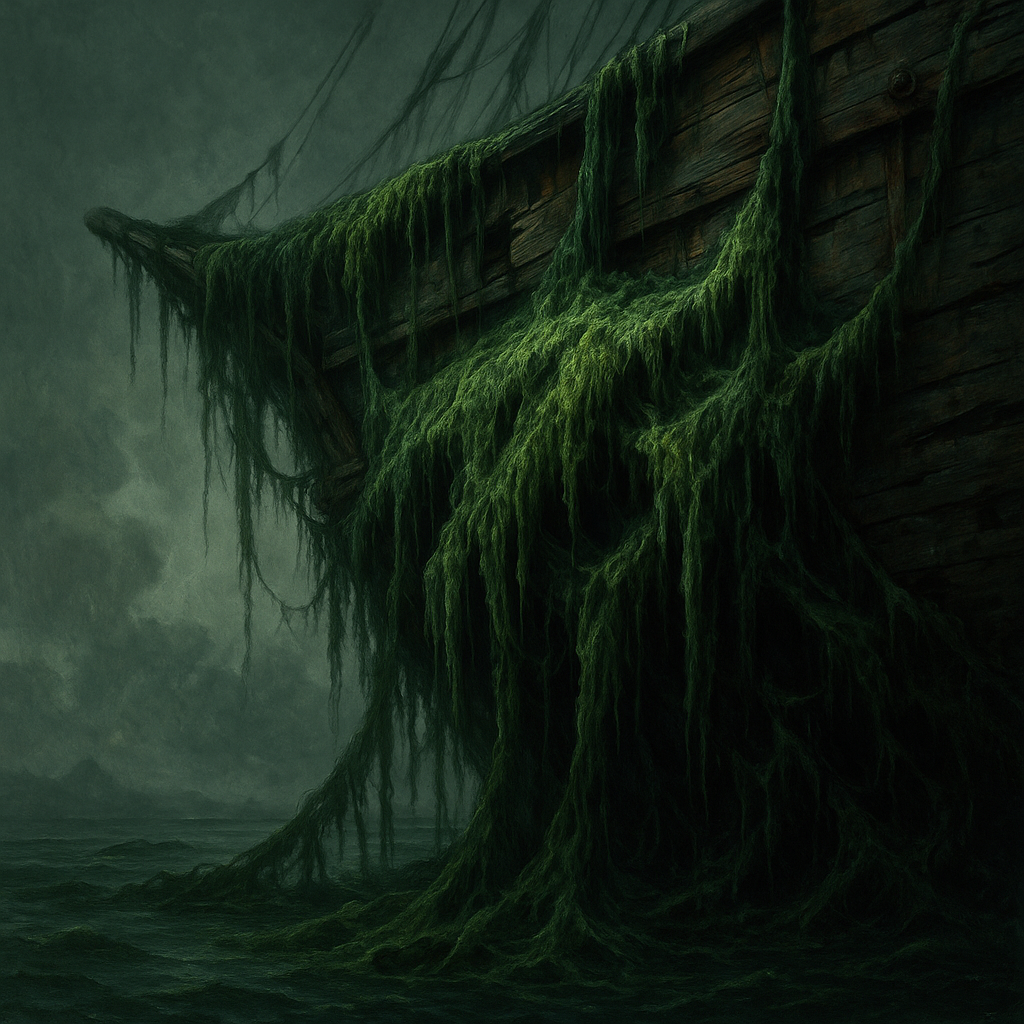Bittermoss
"The sea has teeth, but Bittermoss has a grudge."
At first glance, Bittermoss appears to be little more than brackish scum, the sort of slick green-black growth that clings to the forgotten bellies of old ships or the rotted ribs of storm-broken piers. Yet in Everwealth, nothing clings without reason. Bittermoss is both a ward and a warning, a moss with strange preservative qualities and a reputation for quiet doom. Found clinging in thick mats along the hulls of vessels left too long at anchor, it deters barnacles, worms, and hullrot like no known substance, making it an object of odd reverence among shipwrights and alchemists. But for sailors, the sight of Bittermoss coating a ship’s underbelly stirs unease. Vessels that bear too much of the stuff are said to vanish at sea, or worse, return with no crew aboard, the moss crawling not just beneath the planks, but inside them.
Basic Information
Anatomy
Bittermoss grows in long, trailing mats of sinewy, wet strands ranging from black to bile-green. Its surface is slick to the touch and leaves behind a faint, acrid scent not unlike spoiled vinegar or brine left too long in the sun. Unlike most mosses, it lacks sporing structures, instead growing through fibrous runners that embed into wooden surfaces, stone, or even bone. When dried, it flakes into a fine, bitter powder that stains cloth and skin. Sailors often refer to it as "Anchor's Veil" or "Witchgrass" in hushed tones, unwilling to say its true name at sea.
Genetics and Reproduction
Bittermoss reproduces asexually via fragmentation. Any torn piece, no matter how small, will attempt to root and spread if left in damp, dark conditions. It does not thrive in open water, but rather in the still, salt-laced stagnancy beneath long-docked ships or the crevices of barnacled piers. Its growth accelerates in the presence of rust, rot, and the remains of sea creatures, particularly when mixed with whale-bone or sea-leech excretions.
Growth Rate & Stages
Once established, Bittermoss grows slowly but persistently:
- Initial Attachment: Within a day of contact, tendrils begin to weave into wooden surfaces.
- Matting Phase: Over the course of two weeks, it forms thick, slippery mats that resist most physical removal.
- Colonial Spread: After roughly a month, entire hulls or submerged structures may be veiled in the moss, repelling parasites but becoming marked with the superstition of curse.
Ecology and Habitats
Native to the coastlines of Everwealth and the haunted tidepools of the Bay of Knives, Bittermoss thrives in stagnant, briny water with minimal current. It is most commonly found in ship graveyards, abandoned dockyards, and derelict ferries. In Kibonoji, some reports claim it lines the cavern walls of drowned tunnels. Though rare in active harbors, it spreads readily in times of war, when ships are scuttled, and the tides grow thick with forgotten corpses and iron.
Dietary Needs and Habits
Bittermoss is not photosynthetic. It feeds on minerals drawn from decaying wood, rusting nails, and the residual oils and blood of sea beasts. Saltwater is essential to its survival, though in high enough concentrations, certain coastal alchemists have managed to suspend it in brine jars for study. Attempts to farm it have failed. It does not take to domestication and wilts swiftly in fresh water.
Biological Cycle
Unlike many plants, Bittermoss has no seasonal rhythm. Its growth is tied instead to proximity and exposure, the longer a vessel sits idle in water, the more Bittermoss accrues. Curiously, it seems to halt its spread if a ship is in active motion, leading some to believe it “sleeps” during voyages. Others say it simply waits for its time to strike.
Behaviour
Bittermoss exhibits no sentience, yet strange reports surround its presence. In multiple recorded cases, ships returning after long disappearance are found fully intact but overrun with moss, from keel to sail. Journals are missing. Cargo untouched. Crew: absent. One such vessel, The Whisperjack, was found adrift north of Clammer’s Reef, its hull slick with Bittermoss, every door sealed from the inside, and a single message etched into the deck: “We heard singing.” The ship was burned at sea without unloading.
Additional Information
Perception and Sensory Capabilities
No evidence suggests Bittermoss reacts to light, sound, or temperature, but its uncanny ability to flourish only on immobile vessels, and its seeming preference for iron-rich decay, give rise to speculation. Some claim it senses stagnancy, that it marks those who linger too long without purpose. Whispers in sailor taverns speak of curses laid into its flesh by old gods of the deep.
Scientific Name
Pelagophyta desidiae.
Origin/Ancestry
Legends claim it was first seen clinging to the hull of The Crimson Gallows, a dread vessel belonging to the pirate-mage Rhessa Maldeer, said to sail with a crew of shades. Scholars argue it emerged naturally from the Grandgleam's drowned magickal ruins.
Conservation Status
Actively burned wherever discovered. Certain alchemists and apothecaries pay handsomely for preserved samples, believing Bittermoss has antiseptic or preservative properties. Despite its reputation, a few outlaw shipwrights have begun to secretly coat hulls in powdered Bittermoss to avoid parasitic infestations. Still, any sailor worth their salt would sooner scuttle a ship than sail with moss clinging to its spine.



Comments